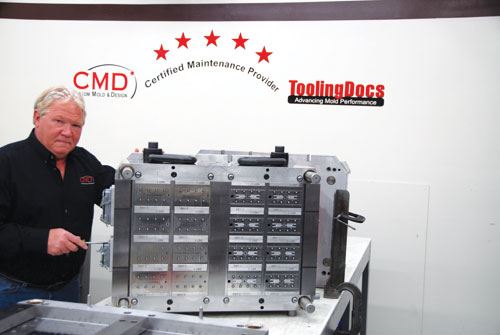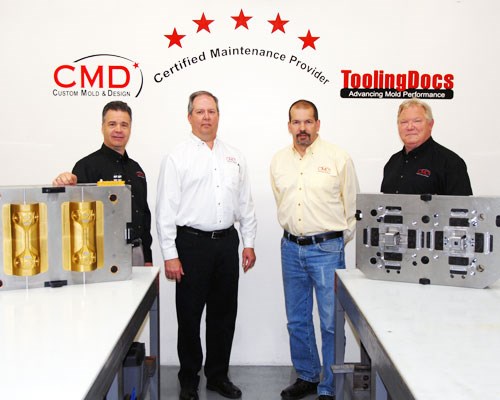Beyond Mold Building and Repair: A Strategy for Increasing Revenue
Although all mold building companies perform mold repair, few form a strategy to actually promote and provide mold maintenance to customers as a plan for growth.
Why is it that all mold manufacturers do mold repair, but few have a plan for promoting and providing mold maintenance for customers? Traditionally the term new molds has been synonymous with good work, and while repair work is welcomed during slow periods, it can be unpredictable, and at times can take resources away from the capability of building new tools.
Beyond a selling strategy towards new tooling, most companies’ processes, equipment and personnel are overwhelmingly geared towards building new tools, and not repairing older molds that were built by them and by others.
However, when a mold building company promotes to its customers its maintenance capability, it can convey an orientation towards the tool’s productivity and efficiency over its life. This, at times, contrasts a customer’s mindset of procuring a cheap tool that carries with it uncertainty as to its future profitability.
Ironically, a mold builder’s orientation beyond primarily providing new tooling could not only gain revenues from maintenance, but also from additional new tools.
An Untapped Market
Custom Mold & Design in New Hope, MN, recognized this opportunity and signed on to become a ToolingDocs Certified Maintenance Provider (CMP).
“We had always done a lot of mold maintenance in our facility,” says Tom Caron, Vice President of Sales at Custom Mold, “but really did not have a comprehensive methodology that tracked reoccurring issues with our customers’ molds. Nothing that was easily recallable. So we looked at the Certified Maintenance Provider program. We had already been searching for creative ways to expand our services to our customers, and grow the business in the process. We asked the question, ‘Can we offer this unique capability as an additional service to improve our level of service to our strategic customers?’ The answer was yes.”
The capability to provide systemized mold maintenance establishes an opportunity to quote a valuable service for customers new and old. One can become a trusted extension of the molder’s toolroom, especially when the customers’ facilities are staffed below sufficient levels of full-time maintenance repair technicians.
Caron says that many of Custom Mold’s target customers have downsized or eliminated their toolrooms, “so with the recent advent of our CMP certification, these companies are very excited about what we can offer them.” He adds that their mold maintenance department has become its own sub-division within the company. It is being monitored as a separate profit center.
Implementation
Custom Mold was evaluated through a comprehensive review, using a systemized assessment process. This data was collected and tallied, delivering a Maintenance Provider Assessment “score card” that addressed key categories:
• Leadership/Management
• Maintenance Strategy/Processes
• Maintenance Documentation Practices
• Shop Skills
• Shop Design
The results were then used to categorize Custom Mold into best practice levels: Reactionary, Basic, Average, Best Practice and Advanced. This assessment points to which categories training and development would be most beneficial.
After the assessment at Custom Mold, implementation began. In-house training occurred, as well as the installation and training of an Electronic Maintenance Management System. In addition, training for key staff occurred at the ToolingDocs Maintenance Center, with its unique shop/classroom facility layout.
After training and system development, a final assessment score (1 thru 5, with 5 being best) was established, and a resulting Best Practice shop level (Reactionary, Basic, Average, Best Practice and Advanced) was determined. A final score of 3.0 or better is required and must be maintained in order to become a Certified Maintenance Provider, and to continue the use of that designation.
In addition to the in-house training, Keith Katnis, Custom Mold’s mold maintenance manager, underwent CMP training at ToolingDocs, saying, “Going into it I didn’t know what to expect. But I had an open mind and wanted to learn, though I had a concern that it’s not easy for an old guy like me with 32 years in the industry to gain new skills! But the curriculum was great and the team has been very available to me, providing sales support and marketing assistance.
“I received an orientation to everything, from TIG welding and polishing to mold evaluation processes to water check techniques and more,” Keith explains. “I also took the Mold Maintenance Manager Certification course and, among other things, learned how to best lead a team, and how to use a documentation system, which will help us track critical mold data and keep everything in sight. We now have an effective way to comprehensively report on and address mold issues for our customers. Anyone who can help their customers not only address the fires, but prevent them before they happen, will be a valuable supplier.
“In the first few weeks since becoming a Certified Maintenance Provider, we won positive customer feedback and new business,” Keith adds. “Now our company can quote customers for new mold projects, along with a mold maintenance program for down the line. Customers tell me they haven’t seen this before and they ask if we’re going to quote providing this service for all of our tools. It’s exciting!”
After initially performing beta testing of their new CMP capabilities with two customers and running several molds through the ToolingDocs mold maintenance process, Custom Mold reviewed the results with its customers.
“The net result of being certified for providing mold maintenance is that we have implemented an advanced, systematic mold maintenance process that provides us and our customers with a competitive advantage,” Caron says. “We are now offering our expanded capability to a broader strategic group of customers.”
Summary
There is a dual benefit to achieving mold maintenance certification status within a mold manufacturing operation. First, there is the advantage of gaining additional revenue from current customers. Meanwhile, a differentiating message can be told to new prospects, one that looks beyond the initial cost of the mold and provides mold buyers the assurance that their tooling program will meet its long-erm objectives.
In a competitive global market, the ability to service what one sells can be a differentiating factor to further serve and grow a mold builder’s customer base.
Related Content
Laser Welding Versus Micro Welding
The latest battle in finely detailed restoration/repair of mold materials.
Read MoreLine Width vs. Depth Ratio in Laser Engraving
A laser does not produce 90-degree sidewalls. It requires a certain amount of draft in order to produce the required pattern.
Read MoreThink Safety: Eliminate Hazards Throughout the Shop
The tooling community is taking advantage of new products for safer mold shops and molding facilities.
Read MoreRead Next
How to Use Strategic Planning Tools, Data to Manage the Human Side of Business
Q&A with Marion Wells, MMT EAB member and founder of Human Asset Management.
Read MoreHow to Use Continuing Education to Remain Competitive in Moldmaking
Continued training helps moldmakers make tooling decisions and properly use the latest cutting tool to efficiently machine high-quality molds.
Read MoreAre You a Moldmaker Considering 3D Printing? Consider the 3D Printing Workshop at NPE2024
Presentations will cover 3D printing for mold tooling, material innovation, product development, bridge production and full-scale, high-volume additive manufacturing.
Read More



















